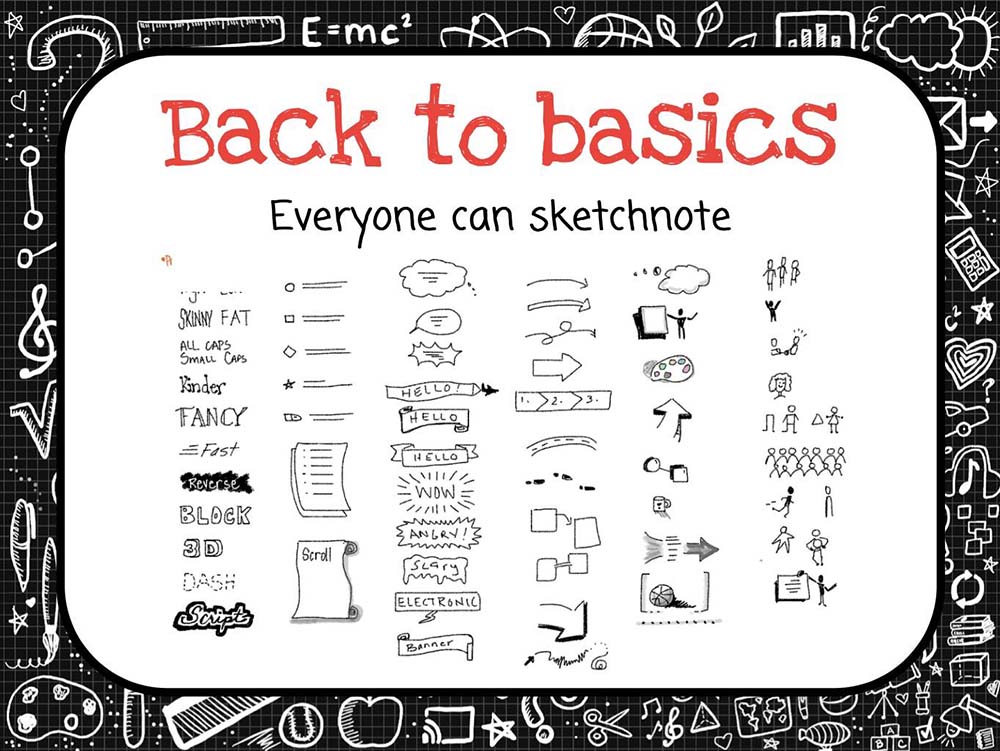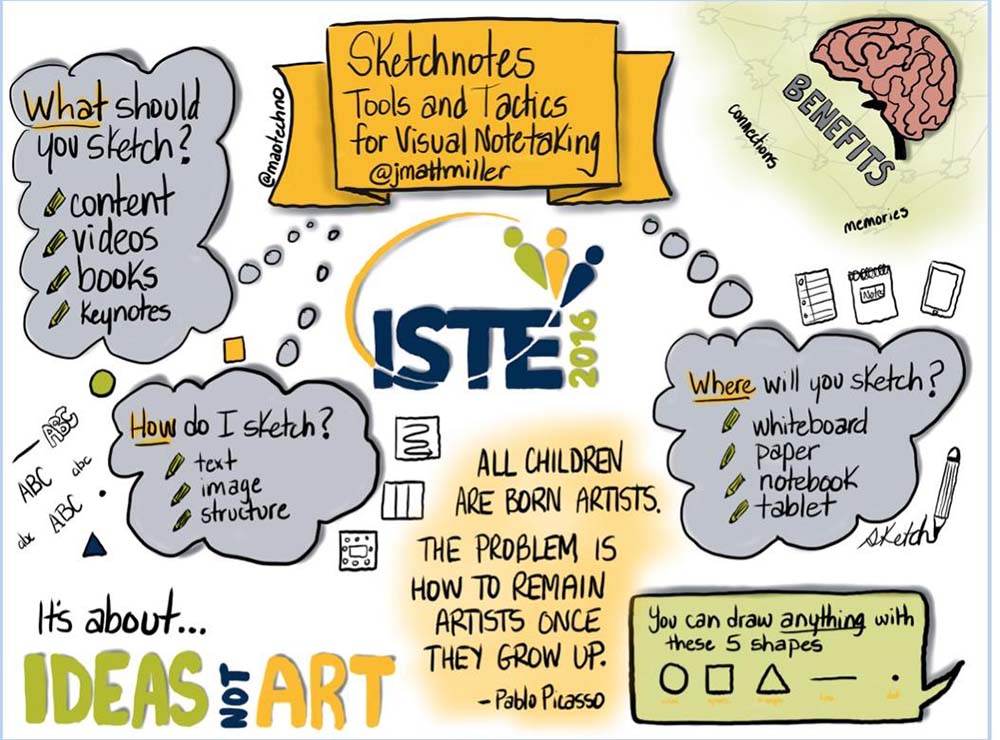Help Students Understand and Recall Concepts with Sketchnoting
A former colleague of mine was a doodler, drawing figures and squiggles through our department meetings. She assured her colleagues that even though it looked like she wasn’t paying attention, nothing could be further from the truth. Doodling while listening helped her focus she assured us.
I had never given serious thought to the educational benefits of doodling until I attended “Make Thinking Visible with Sketchnoting” a SPEAQ conference by Marie-Andrée Ouimet in December 2018. Sketchnoting is a technique for note taking that uses a mix of words and visual elements, including drawings; shapes like lines and arrows; as well as hand-drawn lettering. Sketchnoting is content driven doodling!
The theory behind sketchnoting
A theory from neuroscience called dual coding explains why we should use sketchnoting over plain old text notes. Dual coding is the idea that the brain processes incoming information through 2 channels, one verbal and one visual. When learners activate both channels at once using sketchnoting, Marie-Andrée explains that the brain codes verbal and visual concepts together and builds a visual map of what students are hearing, seeing and thinking.
Sketchnoting activates verbal and visual modes to capture concepts. Your whole brain is absorbed in hearing, synthesizing, and seizing ideas.

Two sketchnotes to explain the theory of dual coding. Source: Marie-Andrée Ouellet, Presentation SPEAQ-2018
You don’t need to be Michelangelo
Sketchnoting is about ideas not art. You should write the key points and avoid summarizing. There are 6 “fundamentals” you can use to easily put your thoughts to paper:
- Lettering: using various typographic treatments to give emphasis to major ideas
- Bullets: to create lists and keep blocks of text tidy
- Frames: shapes (bubbles, boxes, thought clouds) used to enclose words to bring emphasis and structure
- Connectors: arrows and lines to connect ideas. Make a chain of thought.
- Shading: adds dimension and contrast to your notes
- People: stick figures will do to start

“Back to basics, everyone can sketchnote”. Source: Marie-Andrée Ouellet, Presentation SPEAQ-2018
Also with time and some practice you can come up with a collection of icons (emoticons) that you can use over and over again as visual representation of an idea or word.

Sketchnotes from ISTE-2016 Conference (workshop on sketchnoting). Source: Marie-Andrée Ouellet, Presentation SPEAQ-2018
Why sketchnoting?
- promotes the active processing of new concepts
- offers differentiated instruction
- provides a Universal Design for Learning (UDL) strategy
- helps students who struggle taking traditional notes or need a fresh approach to learning
- stimulates creativity and spontaneity
- fosters a useful balance of main ideas and details
- provides an opportunity for knowledge organization skills to develop
- aids understanding and recall
Sketchnoting for more than just note taking
- create a cheat sheet for an exam
- use as a collaborative tool
- review and prepare for an exam
- demonstrate comprehension of a video, article, concept, theory, etc.
- illustrate a plot in a narrative
- summarize a paragraph or a novel
- gather ideas during a brainstorming activity
- rewrite/recast existing notes from class
- organise research notes before writing a paper or creating a video

Have students change a text into Sketchnotes. Source: Marie-Andrée Ouellet, Presentation SPEAQ-2018
Find a medium you like
Some sketchers love to doodle on paper with pen and pencil (and some like my former colleague, are very picky about the paper, pen and pencil they use!)
Maybe you or your students would rather use large sheets pinned to a wall or a white board. However there are some very interesting digital tools that could bring out the sketchnoter in you. Some apps can help you create notes that look way better than what you could do alone on paper:
- One of the best apps for taking notes on an iPad is Paper by WeTransfer (previously Paper by 53). The developer presents its app as an excellent medium for “capturing and organising the thoughts and images that you need every day”. It is free with in app purchases and lets you sketch out ideas with a rich selection of brushes and colors using simple gestures.
- Create talking sketchnotes using ChatterPix. Simply take a photo of the notes you have sketched, draw a line to make a mouth and record your voice. Designed for children, this app’s features make it ideal for college students who benefit from both visual and verbal notes. It is free and also available for Android.
ChatterPix by Duck Duck Moose – Make Anything Talk!
- Create collaborative learning experiences where students and teachers can share notes on thoughts and ideas in real-time using Explain Everything. The free plan allows users to:
- work on up to 3 projects
- use on any device
- collaborate with Voice Chat
- share web video links
- Profweb strives to offer free tools and services to its readers. However, this one of a kind notebook for a cost is worth mentioning. At Marie-Andrée’s workshop I discovered the Rocketbook Everlast, a reusable smart notebook. It combines the utility of the cloud with the feel of pen and paper. You can take your notes and when you’re done wipe them off and start over. Before you erase your work, take a photo with the Everlast app on your phone and your notes will automatically be sent as a PDF or JPG to your preassigned destination, such as a Google Drive folder, Dropbox or email account, etc.
There are so many mediums. Whatever you’re most comfortable with is where you should start.
Stop giving doodling a bad rap!
Apparently the advantages for our brain of drawing sketches, pictures or designs are endless. Doodling, sketching or drawing can be used as mnemonics, to connect images with information and significantly increase students’ ability to remember what they’ve learned.
Universal Design for Learning (UDL) is becoming widely recognised as a way of supporting students’ individual learning styles. Sketchnoting can be used to cater to individual learner differences.
For more ideas and resources, consult Marie-Andrée’s sketchnoting website [in French]: La folie du sketchnote.
Let me hear about your experience with sketchnoting or doodling.

